
Department Field Trips
Experiential Field Visit to India Foundation for the Arts
Date:22 July, 2025
On July 22, 2025, the second-year HSPSO students from the Department of History at Kristu Jayanti Deemed to be University embarked on an experiential field visit to the IFA Archives in Bengaluru. During the visit, students engaged firsthand with an extensive variety of archival materials, including books, films, photographs, performances, and educational resources that reflect India’s rich and diverse cultural landscape. The visit provided the students with insights into how archives are curated, preserved, and made accessible for research, creative practices, and public engagement. The guided walkthrough introduced them to the philosophies and practicalities of archiving as well as India’s lived experiences captured through multiple voices—mainstream and marginal, regional and national. By exploring the IFA Archive's collections and interacting with archivists, the students developed a deeper appreciation for the role of archives in arts, culture, and history, and began to reflect on ways archival work shapes knowledge production and historical memory.
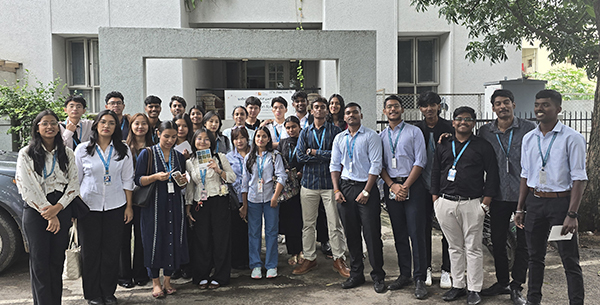
Experiential Field visit to Devanahalli Fort, Bhoga Nandeshwara Temple, Sir M. Vishveshvaraya Museum and Sri Siddhachal Stulabhadra Jain Teerth Dham
Date:09 October, 2024
On October 9, 2024, the Department of History at Kristu Jayanti College (Autonomous) organized a captivating experiential learning visit to several historic and cultural sites. The journey began with a visit to Devanahalli Fort, a 20-acre stone fort originally built by Malla Byre Gowda of the Vijayanagara Empire. Students explored the fort's military architecture, including twelve bastions, and learned about its rich history under the rule of Hyder Ali and Tipu Sultan.
Next, students visited the Bhoga Nandeshwara Temple, known for its architectural grandeur and historical significance. Built between the 9th and 15th centuries, the temple complex features twin shrines dedicated to Lord Shiva.
The third stop was the Sir M. Visvesvaraya Museum in Chikkaballapur, dedicated to the life and achievements of Bharat Ratna awardee Sir Mokshagundam Visvesvaraya, a pioneering civil engineer and statesman.
The final destination was the Sri Siddhachal Stulabhadra Jain Teerth Dham, a modern Jain temple on Chandra Hills, where students observed intricate carvings depicting the 23 Tirthankars of Jainism.
This educational visit offered students a deeper understanding of India's rich historical and cultural heritage, providing valuable insights into architecture, history, and philosophy.
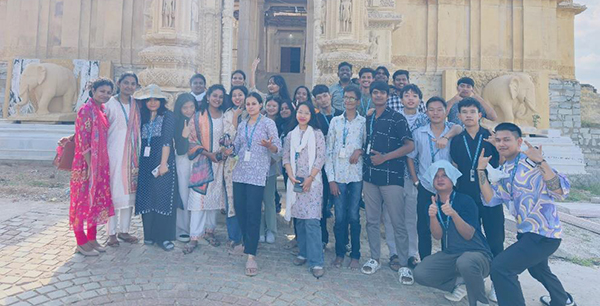
Research Based Experiential Learning: Interaction with Soliga Tribals
Date:02-03 February, 2024
The Department of History at Kristu Jayanti College organized an insightful experiential visit to BR Hills, with the primary objective of immersing students in the rich culture and way of life of the Soliga Tribals. This initiative aimed to provide students with a hands-on understanding of indigenous communities and foster a deeper appreciation for cultural diversity. The program initiated with an enlightening class conducted by the coordinator Mr. Suresh from the Vivekananda Girijana Kalyana Kendra NGO. Students gained valuable insights into the history, traditions, and challenges faced by the Soliga Tribals. The session served as a foundation for the upcoming interactions with the community. Students explored the operations of the Vivekananda Girijana Kalyana Kendra NGO, gaining insights into the various initiatives aimed at supporting and preserving the cultural heritage of indigenous communities. This exposure broadened the students’ perspectives on the role of NGOs in community development. Following the educational session, students had the opportunity to engage directly with the Soliga Tribals. Through guided interactions, students learned about the tribe’s unique customs, traditional practices, and their close connection with the natural surroundings. This hands-on experience allowed for a more nuanced understanding of the Soliga way of life. The day concluded with a memorable tribal dance and campfire gathering, providing an informal setting for students and Tribals to share stories and experiences.

Visit to Belur, Halebeedu and Sravanabelagola, Karnataka
Date:21 January, 2023
The department of History organized an experiential learning programme to historical places of Belur, Halebidu and Sravanabelagola for I and II year BA students on 21/01/23. The study trip was apt for the students of Karnataka history to understand the significant contribution of Hoysala dynasty towards art and architecture with reference to Belur Chennakesava temple and Halebidu Hoysaleswara temple. The Chennakesava temple complex in Belur was built by Hoysala King Vishnuvardhana to commemorate his victory over the Cholas in 1116 AD. The students learnt about the unique sculptural architecture using schist stone or the soft soap stone carvings and sculptures by the Hoysalas rulers between the 10th to 14th centuries.
These were star shaped temple standing on a platform called jagati has exquisite artwork on its outer walls adorned with bracket figures depicting the Puranas and Epics, all carved to perfection. The lower frieze has a series of charging elephants and horses; the elephants symbolize courage while the horses are for speed. Karnataka government has proposed these temples to be listed under UNESCO World Heritage Sites.
In the Evening, the students visited Chandragiri and Vindyagiri Hills in Sravanabelagola. Students explored the Chandragiri hills first where they came across number of inscriptions carved on the stone surface of the hills. The accompanying teachers highlighted the architectural genius of the 58 feet high monolithic Gomateshwara statue and narrated the history behind it. The students then proceeded to the Vidhyagiri Hills and very excited to see what they had learnt in their Karnataka history paper coming alive. The Gommateshwara statue is a 57-foot (17 m) high monolithic statue on Vindhyagiri Hill in the town of Shravanbelagola in the Indian state of Karnataka. It is also called Bahubali. The Jainism culture spread over in the place. The 17.37m tall granite statue weighs about 80 tons and is accessed via a flight of more than 500 steps. The site offers a picturesque view of the plains as well as nearby hills.
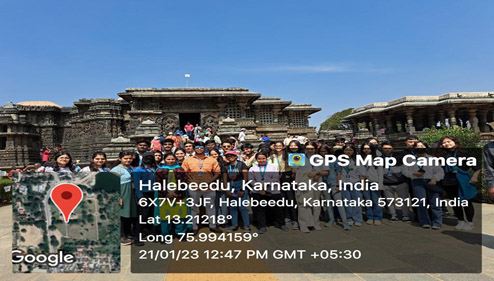
"History on Wheels: Sravanabelagola"
“The Department of History organized a one day trip to Sravanabelagola and the National Institute of Prakrit Studies on 06/12/19 for the IV and VI BA HEP students. The journey started at 6 am from the college campus. The first stop was the Chandragiri and Vindyagiri Hills in Sravanabelagola. Students explored the Chandragiri hills first were they came across number of inscriptions carved on the stone surface of the hills. The accompanying teachers highlighted the architectural genius of the 58 feet high monolithic Gomateshwara statue and narrated the history behind it. The students then proceeded to the Vidhyagiri Hills and very excited to see what they had learnt in their Karnataka history paper coming alive. The historical narratives of the various basadis located on this hill were explained to them. They were also informed about the inscriptions present there.
The group then headed to the National Institute of Prakrit Studies, where they had a workshop on the significance of manuscripts as a source to understanding history. The students got an opportunity to interact with faculties and researchers of the institute.”
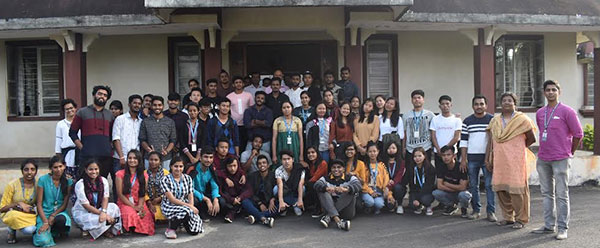
"History on Wheels: Devanahalli Fort"
“The Department of History organized a one day trip on 04/12/19 for the II BA HEP students to the above mentioned places on 04/12/19. The journey started from the college campus at 9 am and the first stop was the Devanahalli Fort. The students were explained the historical significance of the fort and the fact that it is one of the rarest living forts in India was also highlighted. The walk through the fort complex introduced the students to the military driven arrangement of the fort by pointing to the various elements present such as the battlement. The walk also led the students to explore the Venugopalaswamy temple complex inside the fort. Students were able to identify that this temple was one of the oldest among the temples present inside the fort complex. It was explained to them that the courtyard, with a Garuda Stamba, was one of the most spacious one and that the walls of the temple depict various scenes from Ramayana and the feats of Lord Krishna as a child, and that the pillars have beautiful statues carved on them.
The journey continued and made a halt at the Bhoga Nandeeshwara temple. The original temple in the complex was told to the students that it was one of the oldest temples of Karnataka and that it dated back to the early 9th century. The students were thrilled to learn from the Archaeological Survey of India’s tablet that the construction of the temple for Shiva is credited to the Nolamba dynasty ruler Nolambadiraja and the Rashtrakuta emperor Govinda III.
The group then proceeded to the Bharat Ratna Sir M Visvesvaraya Musuem located at Muddenahalli. The students spent time in the museum being inspired by the life and works of one of the greatest Gems of Karnataka, which the Department had already introduced to them earlier this year in a series of lecture.
Before returning to college the group made a final stop at the Shri Shri Nakoda Avanti Jain Temple located near the Devanahalli Fort to know the contribution of Jainism to the state of Karnataka.”
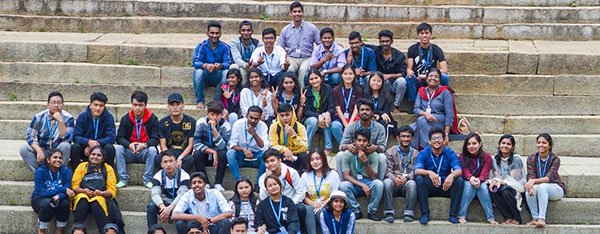
“History on wheels”- Study Trip to Srirangapatana and Mysore
Date: 08/12/18
Class & No. of students: 50 [II BA and VI BA History students]
Places visited
1. Srirangapatnam- Sri Ranganatha Swamy Temple and Daria Daulat Bagh, Palace and Museum
2. Mysore: Mysore Palace, Chamundi Hills and the Monolithic Nandi
3. KRS Dam and Brindavan Garden
The journey started from the college premises at 5 am with 50 students and 2 faculty members. The first stop was Srirangapatnam. Entering the fort complex of Srirangapatnam, the students were introduced to the concept of double fortification and double moat. At Srirangapatnam, the first site was the Sri Ranganatha Swamy Temple. Students were educated on the various categories of architecture (Hoysala, Vijaynagar, Mysore, Woodiya, Haider Ali etc) involved in the temple complex. The group then proceeded to the Daria Daulat Place and gardens of Tipu Sultan. Information regarding the various events of Tipu Sultan was received from the myriad of wall painting and other artefacts in the palace. The journey continued to Mysore and the first stop there was the Mysore Palace. Availing student discount for the students and the faculties, the students were led in the passage to appreciate the extravagant architecture of the palace which is a combination of Hindustani, Islamic and European styles. The group then proceed to Chamundi Hills and view the magnanimous monolithic Nandi structure. The last pit stop for the trip was the KRS Dam and the Brindavan garden.
Learning Outcome:
• Able to understand the historical significance of Mysore and Srirangapatnam
• To view and analyse various architectural styles developed under various dynasties.
Feedback:
• Great experiential learning
• Well organized field visit

HISTORY STUDY TRIP TO HAMPI- BADAMI- AIHOLE- PATTADAKAL
Date: Jan 6th to Jan 9th 2018
No of students attended: 25 IV sem B.A HEP/HTJ students
Staff Escort: Ms. Ramya
Places visited: Hampi- Badami- Aihole- Pattadakal
The Study trip to Hampi commenced on Jan 6th at 9.30 P.M in the college bus with 25 students from IV sem B.A HEP/ HTJ batches in the Kristu Jayanti College Bus. The bus reached the heritage hotel Malligai at Hospet at 5.00 A.M. on Jan 7th After a complimentary breakfast at 7.30, journey to Hampi destinations started.
The well experienced tour guide explained the significance of Hampi as a renowned UNESCO World Heritage Site. The village stands within the ruins of the city of Vijayanagara, the former capital of the Vijayanagara Empire. The prominent places of Hampi such as Virupaksha Temple, Vittala Temple and Hampi Bazaar were visited.The first day ended with the relaxing visit at Tungabhadra Dam, gardens and musical fountain
On the second day we visited Aihole – ancient historic site with numerous Buddhist, Hindu and Jain monuments dated from the fourth century through the twelfth century A.D. Main attraction was the Durga temple and Lad Khan temple. Another UNESCO Heritage site Pattadakal, is a complex of 7th and 8th century A.D was indeed art in its truest form expressing the ingenuity and wealth of tradition of India. Three types of Architecture – Nagara, Vesara and Dravida forms can be clearly seen in the temple complex which includes, the Mallikarjuna Temple, Virupaksha temple and Papanatha Temple.
After a refreshing lunch, we visited Badami or otherwise known as Vatapi. It is famous for its Cave temple- Four caves- dedicated to Vishnu, Siva, Jaina. We also had the opportunity to go to the Badami village Fair.

History study trip to Belur, Halebidu and Sravanabelagola
Date: 20/9/2013
No of students attended: 45 HEP/HTJ students
Staff Escorts: Ms.Ramya
Places visited: Belur at 7.30 A.M -10.30 A.M
The main attraction in Belur is the Chennakeshava temple complex which contains the Chennakesava Temple (dedicated to Chennakeshava, meaning handsome Vishnu) as the centre piece, surrounded by the Kappe Chennigraya temple built by Shantaladevi, queen of king Vishnuvardhana. The KSTDC guide explained to the students the various features of the temple. The first moulding were the temple wall meets the jagati (platform) around the temple is made up entirely of a frieze of elephants. There are two more shrines here that are still in use by devotees and there is a Pushkarni or stepped well to the right side of the main entrance. The Dravida style rayagopuram at the entrance which was a later addition by the Vijayanagar kings, who considered this deity as one of their Kuladevata or family god. The temple is one of the finest examples of Hoysala architecture. It was built by king Vishnuvardhana in commemoration of his victory over the Cholas at Talakad in 1117 CE. Legend has it that it took 103 years to complete and Vishnuvardhana's grandson Veera Ballala II completed the task. The facade of the temple is filled with intricate sculptures and friezes with no portion left blank. The intricate workmanship includes elephants, lions, horses, episodes from the Indian mythological epics, and sensuous dancers (Shilabalikas). Inside the temple are a number of ornate pillars. Darpana Sundari (Lady with the mirror) carved on walls of Belur Temple is one of major attractions in the complex. The credit of carving most of the sculptures goes to Jakanachari.
Halebidu at 11.00 A.M -12.30 A.M
Halebidu (which was previously called Dorasamudra or Dwarasamudra) was the regal capital of the Hoysala Empire in the 12th century. It is home to one of the best examples of Hoysala architecture in the ornate Hoysaleswara and Kedareswara temples. This name is given because this city was ruined two times by Bahmani Sultanate. he temple complex comprises two Hindu temples, the Hoysaleshawara and Kedareshwara temples and two Jain basadi. In front of these temples there is a big lake. The two Nandi statues which are on the side of the Hoysaleshwara temple are monolithic. Soap stone or Chloritic Schist was used for the construction of these temples. However a number of sculptures in the temple are destroyed by invaders. So the temple is incomplete. Halebid means old abode. There is an archeological museum in the temple complex. The Hoysaleswara temple, dating back to the 1121 C.E., is astounding for its wealth of sculptural details. The walls of the temple are covered with an endless variety of depictions from Hindu mythology, animals, birds and Shilabalikas or dancing figures. Yet no two sculptures of the temple are the same. This temple is now being proposed as UNESCO World Heritage Site.
Saravanabelagola 2.00 P.M
The climb to see the statue of Gommateshvara Bahubali at Śravaṇa Beḷgoḷa made the trip adventurous and more interesting. It is one of the most important pilgrimage destinations in Jainism, one that reached a peak in architectural and sculptural activity under the patronage of Western Ganga Dynasty of Talakad. Chandragupta is said to have died here in 298 BC after he became a Jain monk and assumed an ascetic life style. The 57-feet tall monolithic statue of Gommateshvara is located on Vindyagiri Hill. It is considered to be the world's largest monolithic stone statue. The base of the statue has an inscription in Kannada as well as the oldest evidence of written Marathi, i.e. devnagari script, dating from 981 AD. The inscription praises the king who funded the effort and his general, Chavundaraya, who erected the statue for his mother. More than 800 inscriptions have been found at Shravanabelagola, dating to various times from 600 to 1830


